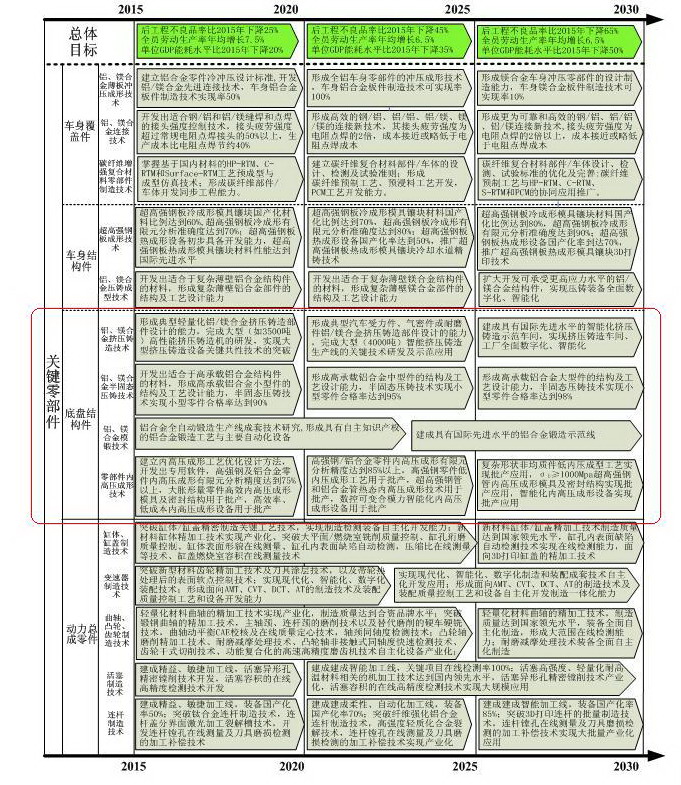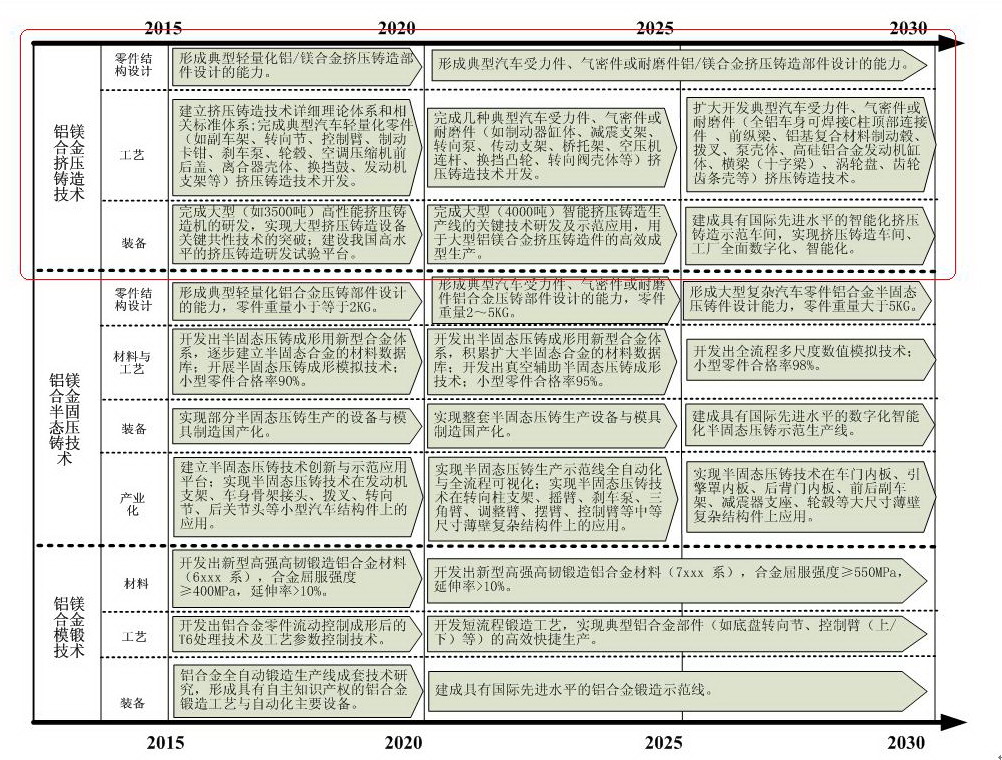1、 The strategic significance of formulating a roadmap for energy-saving and energy vehicle manufacturing technology
Since the beginning of the 21st century, the scale of the automobile industry has continued to grow rapidly. China's automobile production and sales have been ranked first in the world since 2009, making it a true automobile powerhouse. In 2015, the annual production and sales volume exceeded 24 million vehicles. The automobile manufacturing industry involves a huge industrial chain from raw materials such as steel, component manufacturing, complete machine manufacturing to after-sales maintenance. It plays a huge driving role in upstream and downstream industries such as steel, petrochemicals, rubber, electromechanical equipment, high-end CNC machine tools, robots, logistics, and sales. It is an important pillar industry for China to maintain stable economic growth, promote urbanization, and achieve comprehensive prosperity.
China's automobile manufacturing industry has experienced rapid development since the reform and opening up in the 1980s. From introduction and absorption to independent innovation, it has already established a complete manufacturing technology system and strong industrial production capacity. A number of well-known automobile brands have emerged, some of which have already entered overseas markets. However, there is still a significant gap between the overall level of China's automobile manufacturing industry and developed countries in Europe and the United States, particularly reflected in: 1) the quality of product manufacturing still needs to be further improved, and there is an urgent need to establish a quality brand image for domestic automobiles; 2) The core manufacturing processes and equipment still heavily rely on imports, resulting in high investment and operating costs, which seriously constrain market competitiveness; 3) The ability to achieve mass customization for different consumer demands in domestic and international markets, as well as the level of flexibility and intelligence in manufacturing systems, still needs to be improved; 4) We still need to increase technology research and application in areas such as green manufacturing, energy conservation and emission reduction, and resource conservation. In 2015, China's domestic brand automobile production and sales exceeded 40%, but the vast majority of products were concentrated in the middle and low-end markets below 100000 yuan, and the export industry was mostly in regions such as Asia, Africa, Latin America, and the Middle East. China's automobile manufacturing powerhouse still faces huge challenges.
Quality first "is one of the core ideas in China's strategy of building a strong manufacturing nation. In the face of the demand for energy-saving and new energy vehicle development, as well as fierce competition in the domestic and international automobile markets, it is necessary to integrate the advantageous resources of government, industry, academia, research, and application, strive to improve the overall level of manufacturing technology in China's automobile industry, achieve high-quality and high-efficiency mass customization capabilities, and create a number of Chinese made automobile brands with international competitiveness. The research and formulation of the "Automotive Manufacturing Technology Roadmap" will help the Chinese government and the automotive industry to unify their understanding, focus on key technologies and implementation paths, and connect the entire innovation chain from basic original research to large-scale industrial applications, laying an important foundation for achieving the grand goal of China's automotive industry moving from a manufacturing power to a manufacturing powerhouse.
2、 Editor in Chief: Manufacturing Branch of China Society of Automotive Engineers, Dongfeng Motor Corporation
3、 Main writing units: Dongfeng Motor Corporation, China FAW Group Corporation, Shanghai Jiao Tong University, Huazhong University of Science and Technology, Jingjin Electric Technology Co., Ltd., Jiangsu Hengshen Co., Ltd., Suzhou Sanji Casting Equipment Co., Ltd., Hubei University of Technology, Kande Composite Materials Co., Ltd
4、 Participants: Dongfeng Motor Corporation, China First Automobile Group Corporation, SAIC Motor Group Co., Ltd., Chongqing Chang'an Automobile Co., Ltd., Guangzhou Automobile Group Co., Ltd., BYD Co., Ltd., Beijing New Energy Automobile Co., Ltd., Zhengzhou Yutong Group Co., Ltd., Tsinghua University, Jilin University, Harbin Institute of Technology, Xi'an Jiaotong University, Northwest University of Technology, South China University of Technology, Wuhan University of Technology, Chongqing University, Chinese Academy of Sciences Chongqing Green Manufacturing Technology Research Institute, Chinese Academy of Sciences Shenyang Institute of Automation, General Research Institute of Mechanical Science, No. 9 Design and Research Institute of Mechanical Industry Co., Ltd., Dongfeng Design and Research Co., Ltd., Beijing Nonferrous Metals Research Institute, Suzhou Nonferrous Metals Research Institute Co., Ltd Changtai Robot Co., Ltd., Kangde Composite Materials Co., Ltd., Jiangsu Qiyi Technology Co., Ltd., Shanghai Electric Drive Co., Ltd., Keliyuan Hybrid Power Technology Co., Ltd., Shanghai Automotive Transmission Co., Ltd., Zhixin Motor Co., Ltd., Beijing Jingci Technology Co., Ltd., Guangxi Yuchai Machinery Co., Ltd., Huawei Technology Co., Ltd., Dalian Machine Tool Group Co., Ltd., Lijin Group. Shanghai Yida Machinery Co., Ltd., Guangzhou Jinbang Liquid Forging Technology Co., Ltd., Shiyan Tongchuang Transmission Technology Co., Ltd., Baosteel Group Co., Ltd., Aluminum Corporation of China Limited
Roadmap for Manufacturing Technology of Aluminum Magnesium Alloy Components - Led by expert Shi Jianpeng from Dongfeng Motor Corporation's Technical Center, compiled by experts Li Feipeng and Lei Jian from Dongfeng Commercial Vehicle Technical Center. The "Roadmap for Aluminum Magnesium Alloy Thin Plate Stamping Technology" was compiled by Dongfeng Die Stamping Company, the "Roadmap for Aluminum Magnesium Alloy Extrusion Casting Technology" was compiled by Suzhou Sanji, the "Roadmap for Aluminum Magnesium Alloy Semi solid Forming Technology" was compiled by Beijing Nonferrous Metals Research Institute, and the "Roadmap for Automotive Connection Technology" was compiled by Hubei University of Technology. The technical center of Dongfeng Motor Corporation, Dongfeng Commercial Vehicle Technology Center, FAW Casting Company, Dongfeng Nonferrous Casting Company, Beijing Nonferrous Metals Research Institute, Suzhou Nonferrous Research Institute, Lijin Yida, Guangzhou Jinbang and other units cooperated.
5、 Roadmap for Manufacturing Technology of Chassis Structural Components (excerpted from "Roadmap for Manufacturing Technology of Energy saving and New Energy Vehicles")
1. Aluminum and magnesium alloy extrusion casting, semi-solid die casting, and forging technology
(1) Expected goals
1) In 2020, the ability to design typical lightweight aluminum/magnesium alloy extrusion casting components was formed, and the research and development of large-scale (such as 3500 tons) high-performance extrusion casting machines was completed, achieving breakthroughs in key common technologies of large-scale extrusion casting equipment; Developing materials suitable for high load-bearing aluminum alloy structural components, utilizing semi-solid die casting technology to form the structural and process design capabilities for high load-bearing aluminum alloy small parts, and achieving a 90% qualification rate for small parts through semi-solid die casting technology; Develop aluminum alloy forging processes and automation equipment with independent intellectual property rights;
2) By 2025, the ability to design aluminum/magnesium alloy extrusion casting components for typical automotive load-bearing parts, airtight parts, or wear-resistant parts will be formed, and key technology research and demonstration applications for large-scale (4000 tons) intelligent extrusion casting production lines will be completed; The semi-solid die casting technology forms the structural and process design capability of high load-bearing aluminum alloy medium-sized parts, and achieves a qualification rate of 95% for small parts through semi-solid die casting technology; Build an aluminum alloy forging demonstration line with international advanced level;
3) By 2030, an intelligent extrusion casting demonstration workshop with international advanced level will be built, achieving comprehensive digitization and intelligence of extrusion casting workshops and factories; The semi-solid die casting technology forms the structural and process design capability of high load-bearing aluminum alloy large parts, and achieves a qualification rate of 98% for small parts through semi-solid die casting technology.
(2) Key tasks
At present, there is a certain gap in the performance of aluminum alloy and magnesium alloy materials compared to foreign countries; Lack of research on domestic manufacturing processes, unstable processes, and difficulty in meeting product requirements; Domestic production efficiency is relatively low, and large equipment relies on imports. Breakthroughs are needed in key technologies such as squeeze casting, semi-solid die casting, and forging for the forming and application of aluminum/magnesium alloy parts for chassis structural components.
1) Aluminum and magnesium alloy extrusion casting technology
In terms of squeeze casting, China's adoption of squeeze casting technology for automotive parts is still in its infancy: there is no technical standard for automotive squeeze casting technology; The molding technology and equipment are far behind Europe, America, and Japan, and large-scale equipment relies on imports and is restricted. Europe and America have extensive applications in squeeze casting automotive parts, and Japan produces millions of squeeze casting car steering knuckles every year.
2) Semi solid die casting technology for aluminum and magnesium alloys
In terms of semi-solid die casting, semi-solid forming technology has been maturely applied in North America, Europe, Japan, and South Korea for the production of high-end automotive components; China conducted research on semi-solid forming technology during the Ninth Five Year Plan period and has now entered the stage of industrial promotion. Its application in the domestic automotive market is still in its infancy; There is still a significant gap in equipment and mold design for semi-solid slurry preparation in China.
3) Aluminum and magnesium alloy forging technology
In terms of forging: foreign passenger car steering knuckles, control arms, connecting rods and other functional components have already adopted aluminum forgings instead of steel forgings, and their process technology is mature, achieving a weight reduction of more than 50%; There are few domestic material varieties, and the mechanical properties of the materials cannot fully meet the requirements. It is urgent to develop high-strength and high toughness aluminum alloy materials suitable for forging and forming; The domestic forging process is unstable, and the level of process technology and mold design is relatively backward, which can only produce some parts with relatively simple shapes; The automation and specialization level of domestic forging production equipment is low, mainly relying on manual operation for production, which makes it difficult to accurately control process parameters and has low production efficiency.
(3) Roadmap

节能与新能源汽车制造总体技术路线图

铝、镁合金成型制造技术路线图




 Official Wechat Public Number
Official Wechat Public Number